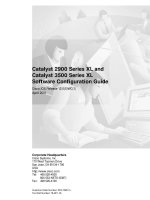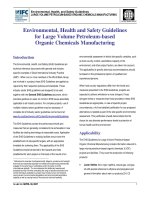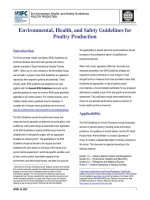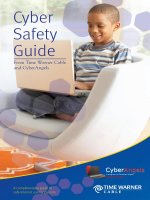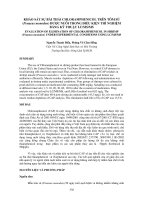Agilent 6000 series lc ms safety guide
Bạn đang xem bản rút gọn của tài liệu. Xem và tải ngay bản đầy đủ của tài liệu tại đây (259.41 KB, 16 trang )
Agilent 6000 Series LC/MS
Safety Guide
Safety 2
Symbols on Instruments 2
General Instrument Safety 5
Physical Hazard Safety 6
General Chemical Safety 9
Chemical Waste Safety 10
Biohazard Safety 11
Conformity and Standards 12
Safety and Regulatory Certifications 12
Electromagnetic Compatibility 13
Environmental Conditions 14
Sound Emission Declaration 14
This guide contains information about safety, conformity and standards for
your Agilent 6000 Series LC/MS.
WARN I NG
Always wear appropriate protection, including eye protection, lab coat, and gloves,
when working with solvents and chemicals or when working with unassembled
parts.
Safety
Symbols on Instruments
Safety
Symbols on Instruments
Electrical symbols
The following table describes the electrical symbols that can be displayed on
the LC/MS instrument.
Table 1
Symbol
Electrical symbols
Description
Indicates a protective earth terminal.
Indique une borne de terre de protection.
Circuit breaker.
Disjoncteur.
Alternating current
Courant alternatif
Fuse
Fusible
2
6000 Series LC/MS Safety Guide
Safety
Symbols on Instruments
Safety symbols
The following table describes the safety symbols that can be displayed on the
LC/MS instrument. Each symbol appears by itself or with text that explains
the relevant hazard. These safety symbols can also appear next to DANGER,
WARNING, or CAUTION.
Table 2
Safety symbols
Symbol
Description
or
The apparatus is marked with this symbol when the
user should refer to the instruction manual in order
to protect against harm to the operator and to
protect the apparatus against damage.
L'appareil est marqué avec ce symbole lorsque
l'utilisateur doit se référer au manuel d'instruction
afin de protéger contre les atteintes à l'opérateur et
pour protéger l'appareil contre les dommages.
Indicates dangerous voltages.
Indique des tensions dangereuses.
The apparatus is marked with this symbol when hot
surfaces are accessible and the user should not
touch them when heated up.
L'appareil est marqué avec ce symbole lorsque les
surfaces chaudes sont accessibles et que
l'utilisateur ne doit pas les toucher lorsqu'elles sont
chaudes.
Electrostatic discharge (ESD) hazard to equipment.
Risque de décharge électrique à l'équipement
Explosion hazard.
Risque d'explosion
6000 Series LC/MS Safety Guide
3
Safety
Symbols on Instruments
Table 2
Symbol
Safety symbols (continued)
Description
Do not operate the instrument in the presence of
hydrogen or any other flammable gases or fumes.
Operation of any electrical instrument in such an
environment constitutes a definite safety hazard.
Ne pas utiliser l'instrument en présence de gaz ou de
vapeurs inflammables. L'utilisation de tout
instrument électrique dans un tel environnement
constitue un danger certain.
Do not discard this electrical/electronic product in
domestic household waste.
Ne jetez pas ce produit électrique / électronique
avec les ordures ménagères.
Disconnect main plug from electrical outlet prior to
fuse replacement.
Débranchez la prise principale de la prise électrique
avant de remplacer le fusible.
Two live circuits. Disconnect both power cords
before maintenance.
Deux circuits sous tension. Débranchez les deux
cordons d'alimentation avant l'entretien.
Biological risks
Dangers biologiques
4
6000 Series LC/MS Safety Guide
Safety
General Instrument Safety
General Instrument Safety
WARN I NG
PHYSICAL INJURY HAZARD: Use the LC/MS instrument only as specified in the
user instructions. Using the system in a manner not specified by Agilent
Technologies can result in personal injury or damage to the instrument.
Moving or lifting the system
WARN I NG
PHYSICAL INJURY HAZARD: The LC/MS instrument is heavy. The 6100 series
LC/MS instruments require at least two people to lift the instrument. The 6200,
6400, and 6500 series LC/MS instruments require at least four people.
Operating the instrument
Before you operate the instrument, make sure that you have:
• Been given instructions on general safety practices for laboratory and
specific safety practices for the instrument.
• Read and understood all material safety data sheets (MSDS) for chemicals
handled.
6000 Series LC/MS Safety Guide
5
Safety
Physical Hazard Safety
Physical Hazard Safety
Solvents
WARN I NG
PHYSICAL INJURY HAZARD: Always wear appropriate protection, including eye
protection and gloves, when working with solvents and chemicals. Refer to the
applicable MSDS for more information about the materials you are working with.
Electrical safety
WARN I NG
When the LC/MS instrument is plugged into a power source, even if the power
switch is off, dangerous voltages can exist:
• In the wiring between the LC/MS instrument power cord and the AC power
supply.
• In the AC power supply
• In the wiring from the AC power supply to the power switch.
WARN I NG
Never remove a cover unless specifically instructed to do so. With the power
switch on, potentially dangerous voltages can exist:
• On all electronics boards in the instrument.
• In the internal wires and cables connected to these boards.
• In the wires for any heater.
CA U T I O N
6
The printed circuit (PC) boards in the LC/MS instrument can be damaged by
electrostatic discharge. Do not touch any of the boards unless absolutely necessary. If
you must handle the PC boards, wear a grounded wrist strap and take other anti-static
precautions. Wear a grounded wrist strap any time you must remove the LC/MS
instrument covers.
6000 Series LC/MS Safety Guide
Safety
Physical Hazard Safety
WARN I NG
Severe electrical shock can result from operating the LC/MS instrument without
the correct Agilent power cords in place.
Grounding circuit continuity is required for the safe operation of equipment.
Use properly configured and approved line cords for the voltage supply in your
facility. Refer to the Site Prep Guide for details.
WARN I NG
If the power cord insulation is damaged, frayed, or worn, replace the cord. Contact
your Agilent representative.
WARN I NG
Plug the LC/MS instrument AC input power cords into properly grounded
receptacles with adequate current capacity. The branch circuit over-current
protection Circuit Breakers protecting the building receptacles must be rated no
more than 20A.
WARN I NG
Be sure that the LC/MS main supply cable is routed in such a way as to minimize
the risk of a tripping hazard. Agilent Technologies recommends the use of
mechanical protection, such as a rubberized cable guard on the floor to cover and
protect the main supply cable.
WARN I NG
Make sure that the point at which the detachable power cords are connected to the
LC/MS instrument is clear from clutter and that it is accessible at all times.
WARN I NG
Do not interrupt the protective conductor inside or outside the LC/MS system or
disconnect the protective earth terminal. Such actions create a shock hazard for the
operator and can damage the instrument.
6000 Series LC/MS Safety Guide
7
Safety
Physical Hazard Safety
WARN I NG
The use of incorrect or makeshift fuses or the short-circuiting of fuse holders
creates a shock hazard for the operator and can damage the instrument. Replace
fuses only with fuses of identical current rating and type. Refer to the Maintenance
Guide for more information.
WARN I NG
Excessive fluctuations in the line voltage can create a shock hazard and can
damage the instrument. This equipment must be installed in a Category II
environment as defined in IEC 664.
For all instruments, the supply voltage must not fluctuate more that ±10%.
For any instrument with an Agilent Jet Stream source, the line voltage must not
fluctuate more that +10/-5% from the rated voltage.
Temperature safety
WARN I NG
Some parts of the LC/MS instrument operate at temperatures high enough to cause
serious burns. Always cool heated parts of the LC/MS down to room temperature
before you work on them.
To cool the instrument faster, set the heated zone to room temperature. Turn the
zone off after it has reached the set point.
If you must do maintenance work on a hot part, use a wrench and wear gloves.
Drying-out Process
WARN I NG
Some parts of the LC/MS instrument operate at temperatures high enough to cause
serious burns. Always cool heated parts of the LC/MS down to room temperature
before you work on them.
To cool the instrument faster, set the heated zone to room temperature. Turn the
zone off after it has reached the set point.
If you must do maintenance work on a hot part, use a wrench and wear gloves.
8
6000 Series LC/MS Safety Guide
Safety
General Chemical Safety
General Chemical Safety
WARN I NG
CHEMICAL HAZARD: Before handling any chemicals, refer to the Material Safety
Data Sheet (MSDS) provided by the manufacturer, and observe all relevant
precautions.
To minimize the hazards of chemicals:
• Read and understand the MSDS provided by the manufacturer before you
store, handle, or work with any chemicals or hazardous materials.
• Minimize contact with chemicals. Wear appropriate personal protective
equipment when handling chemicals (for example, safety glasses, gloves, or
protective clothing).
• Minimize the inhalation of chemicals. Do not leave chemical containers
open. Use only with adequate ventilation (for example, fume hood).
• Check regularly for chemical leaks or spills. If either of those occur, follow
the cleanup procedures from the manufacturer, as recommended in the
MSDS.
• Comply with all local, state/provincial, or national laws and regulations
related to chemical storage, handling, and disposal.
6000 Series LC/MS Safety Guide
9
Safety
Chemical Waste Safety
Chemical Waste Safety
WARN I NG
CHEMICAL WASTE HAZARD: Wastes produced by the LC/MS System are
potentially hazardous and can cause injury, illness, or death. Refer to Material
Safety Data Sheets and local regulations for handling and disposal.
WARN I NG
CHEMICAL WASTE HAZARD: The iFunnel pump, foreline pump, and source exhaust
contain traces of the chemicals that you are analyzing. The exhaust products can be
toxic. Vent the pump and source exhaust outside your laboratory or into a fume
hood. Make sure to comply with all local environmental regulations.
To minimize the hazards of chemical waste:
• Read and understand the MSDS provided by the manufacturers of the
chemicals in the waste container before you store, handle, or dispose of
chemical waste.
• Provide primary and secondary waste containers. Both containers must be
compatible with the waste material and meet federal, state/provincial, and
local requirements for container storage.
• Minimize contact with chemicals. Wear appropriate personal protective
equipment when handling chemicals (for example, safety glasses, gloves, or
protective clothing).
• Minimize the inhalation of chemicals. Do not leave chemical containers
open.
• Handle chemical wastes in a fume hood.
• After emptying a waste container, seal it with the cap provided.
• Dispose of the contents of the waste tray and waste bottle in accordance
with good laboratory practices and local, state / provincial, or national
environmental and health regulations.
• Ensure that the LC/MS instrument waste is stored, transferred,
transported, and disposed of according to all local, state / provincial,
and/or national regulations.
10
6000 Series LC/MS Safety Guide
Safety
Biohazard Safety
Biohazard Safety
WARN I NG
If pathogenic, toxic, or radioactive samples are intended to be used in this
instrument, it is the responsibility of the user to ensure that all necessary safety
regulations, guidelines, precautions and practices are adhered to accordingly. This
includes also the handling of genetically modified organisms. Ask your laboratory
safety officer to advise you about the level of containment required for your
application and about proper decontamination or sterilization procedures to follow
if fluids escape from containers.
To minimize hazards of biological material:
• Observe all cautionary information printed on the original solution
containers prior to their use.
• Because leaks, spills, or loss of sample can generate aerosols, observe
proper safety precautions.
• Spray chamber covers are not designed as bioseals for aerosol or liquid
containment.
• Handle body fluids with care because they can transmit disease. No known
test offers complete assurance that they are free of micro-organisms. Some
of the most virulent - Hepatitis (B and C) and HIV (I-V) viruses, atypical
mycobacteria, and certain systemic fungi - further emphasize the need for
aerosol protection.
• Always follow local state and federal biohazard handling regulation when
disposing of biohazardous waste material.
• Handle all infectious samples according to good laboratory procedures and
methods to prevent spread of disease.
• Dispose of all waste solutions and products according to appropriate
environmental health and safety guidelines.
6000 Series LC/MS Safety Guide
11
Conformity and Standards
Safety and Regulatory Certifications
Conformity and Standards
The Agilent 6000 Series LC/MS are assigned the following IEC (International
Electro-technical Commission) classifications:
• Equipment Class: I (Laboratory Equipment)
• Installation Category: II
• Pollution Degree: 2
This unit has been designed and tested in accordance with recognized safety
standards and is designed for use indoors. If the instrument is used in a
manner not specified by Agilent Technologies, the protections provided by
the instrument may be impaired.
Safety and Regulatory Certifications
The Agilent 6000 Series LC/MS conforms to applicable editions and versions
of the following safety standards:
• Canadian Standards Association (CSA): CAN/CSA–C22.2 No. 61010–1,
CAN/CSA-C22.2 No. 61010-2-010, CAN/CSA-C22.2 No. 61010-2-101 (IVD
devices only)
• CSA/Nationally Recognized Test Laboratory (NRTL): UL 61010–1:2005
• International Electrotechnical Commission (IEC): IEC61010–1,
61010-2-010, 61010-2-101 (IVD devices only)
• EuroNorm (EN): EN61010–1, 61010-2-010, 61010-2-101 (IVD devices only)
The Agilent 6000 Series LC/MS conforms to the following regulations on
Electromagnetic Compatibility (EMC) and Radio Frequency Interference
(RFI):
• CISPR 11/EN 55011: Group 1, Class A
• IEC/EN 61326-1, IEC/EN 61326-2-6 (IVD devices only)
• AUS/NZ CISPR 11
• Canada ICES-001 (Cet appareil ISM est conforme a la norme NMB—001 du
Canada.)
The Agilent 6000 Series LC/MS is designed and manufactured under a quality
system registered to ISO 9001.
12
6000 Series LC/MS Safety Guide
Conformity and Standards
Electromagnetic Compatibility
Electromagnetic Compatibility
Operation of the mass spectrometer is subject to the following two conditions:
• This device may not cause harmful interference.
• This device must accept any interference received, including interference
that may cause undesired operation.
If the mass spectrometer does cause harmful interference to other equipment,
which can be determined by turning the mass spectrometer off and on, try one
or more of the following measures:
1 Relocate the susceptible equipment.
2 Move the mass spectrometer away from the susceptible equipment.
3 Plug the devices into different electrical outlets, so that the devices are on
separate electrical circuits.
4 Make sure that all peripheral equipment connected to the mass
spectrometer are also certified.
5 Make sure that appropriate cables are used to connect the mass
spectrometer to peripheral equipment.
6 Consult your equipment dealer, Agilent Technologies, or an experienced
technician for assistance.
Changes or modifications not expressly approved by Agilent Technologies
could void the user's authority to operate the equipment.
6000 Series LC/MS Safety Guide
13
Conformity and Standards
Sound Emission Declaration
Sound Emission Declaration
Sound pressure
Sound pressure Lp < 70 dB
Schalldruckpegel
Schalldruckpegel Lp < 70 dB
Environmental Conditions
Equipment Class
Class I Laboratory Equipment
Pollution Degree
2
Installation Category
II
Environment
Indoor Use
Altitude
For 6545XT only, not to exceed 2000 m
For all other LC/MS models, not to exceed 3000 m
14
Electrical supply
200 - 240 V AC, 50/60 Hz, maximum 2850 VA
Mains supply voltage
Fluctuations not to exceed 10% of nominal supply
voltage. For instruments with an Agilent Jet Stream
source, fluctuations should not exceed +10/-5% from
the rated voltage.
Operating Temperature
15 to 35°C (59 to 95°F)
Humidity
< 85% RH at 35°C
6000 Series LC/MS Safety Guide
This page intentionally left blank.
www.agilent.com
In This Book
This guide contains safety
and regulatory information
for your Agilent 6000
Series LC/MS system.
Original Language - EN
Agilent Technologies, Inc. 2017
Printed in USA
Revision A, June 2017
*G1960-90113*
G1960-90113
